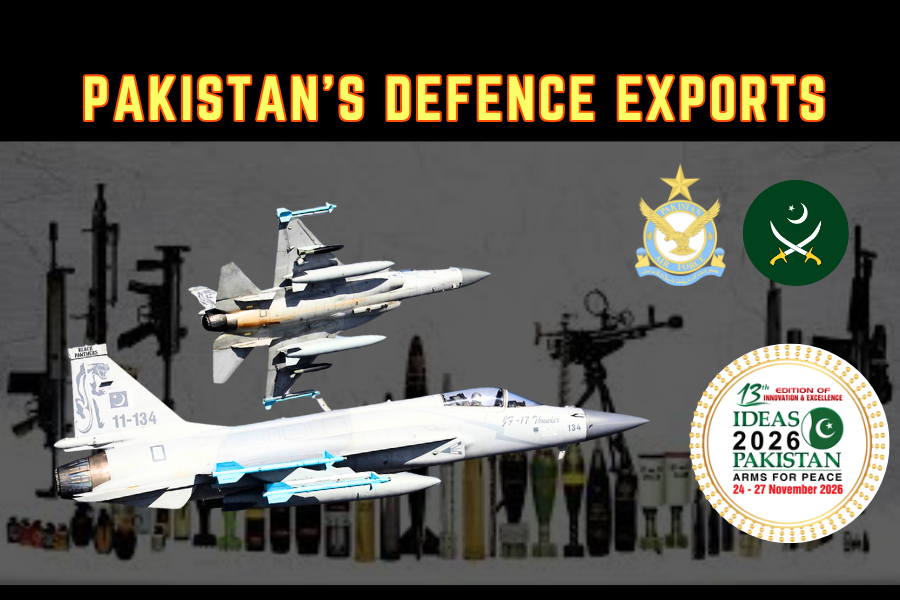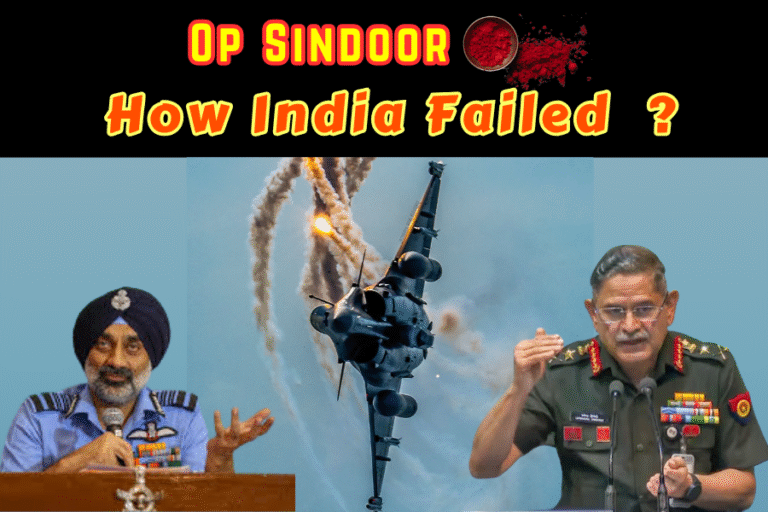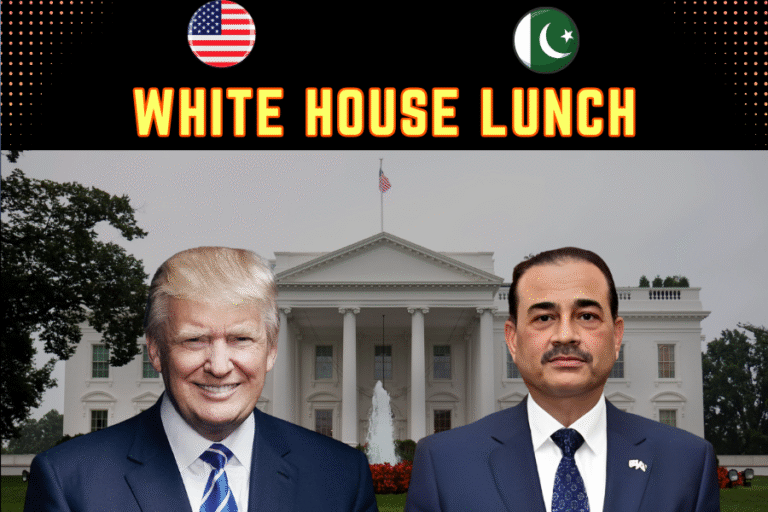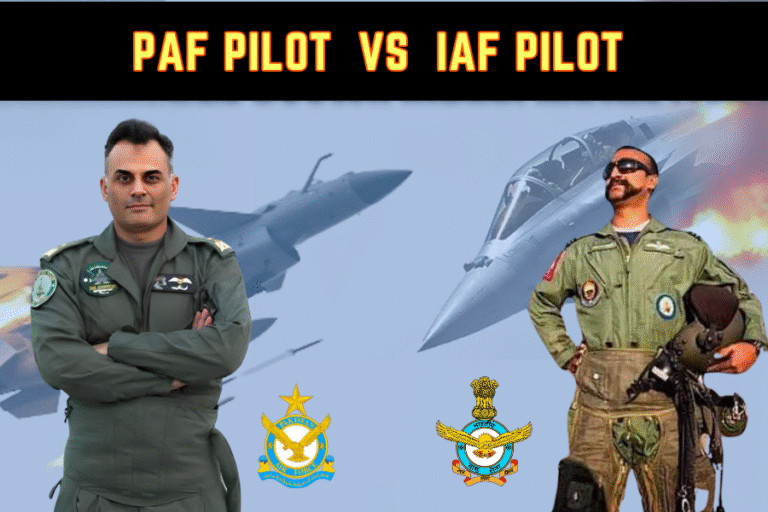(By Khalid Masood)
In the crucible of South Asia’s geopolitical rivalries, Pakistan has forged a formidable defence industrial base, transitioning from a regional arms producer to an emerging global exporter. For decades, Pakistan Ordnance Factories (POF) and Heavy Industries Taxila (HIT) have supplied ammunition and armored vehicles to nations across Asia and Africa. Yet, it is the JF-17 Thunder—a 4.5-generation fighter jet co-developed with China—that has catapulted Pakistan into the spotlight of the global arms trade. With a reported $4.2 billion deal for 40 JF-17 Block III jets to Azerbaijan in May 2025, Pakistan stands poised to redefine its role in a $110 billion market dominated by the U.S., Russia, and China (SIPRI, 2024; Web:5). This article, grounded in Pakistan’s defence export history, technical capabilities, and strategic vision, explores its journey to becoming a global arms exporter, the game-changing potential of JF-17 deals, and the challenges that lie ahead.
1. Historical Foundations: A Legacy of Self-Reliance
Pakistan’s arms production began in 1951 with POF Wah, established to meet the nascent state’s military needs (POF.gov.pk, 2025). By the 1970s, sanctions following the 1965 and 1971 Indo-Pak wars spurred self-reliance, leading to HIT’s creation in 1971 for tanks and APCs (HIT.gov.pk, 2025). The 1990s U.S. Pressler Amendment, halting F-16 deliveries, catalyzed partnerships with China, culminating in the Al-Khalid tank and JF-17 program (CSIS, Feb 2025; Web:14).
Since the 1980s, Pakistan has exported small arms, ammunition, and artillery to over 40 countries, including Saudi Arabia, UAE, and Sri Lanka (SIPRI, 2024). POF’s 7.62mm rifles, 155mm shells, and mortars, priced 30% below Western equivalents, have sustained a steady $100–200 million annual export stream (Dawn, Jun 2024). By 2023, arms exports surged 400% to $5 million, reflecting growing demand in conflict zones like Ukraine and Yemen (Web:0). This legacy of affordability and reliability underpins Pakistan’s global ambitions.
2. The JF-17 Thunder: A Game-Changer in the Skies
The JF-17, co-developed by Pakistan Aeronautical Complex (PAC) Kamra and China’s Chengdu Aircraft Industry Group, is a multirole fighter designed for cost-effective air superiority and ground attack. Priced at $25–50 million per unit—half the cost of Western jets like the F-16 ($70M)—it boasts AESA radar, PL-15 missiles, and a 1,350 km range (Web:14,19). Its combat debut in the May 2025 Indo-Pak conflict, where Pakistan claims it downed five Indian jets, including Rafales, showcased its lethality, drawing global attention (Web:16,20,22).
Confirmed Export Deals
- Myanmar: In 2017, Myanmar ordered 16 JF-17 Block II jets for $560 million, with deliveries completed by 2022. Despite technical issues grounding some aircraft, the deal marked PAC’s entry into fighter exports (Web:9).
- Nigeria: Nigeria acquired three JF-17 Block II jets in 2021 for $120 million, used against Boko Haram. A potential order for 12 more is under negotiation (SIPRI, 2024; Dawn, May 2025).
- Azerbaijan: The landmark $4.2 billion deal for 40 JF-17 Block III jets, reported in May 2025, is Pakistan’s largest defence export (Web:1,4,5,6). Initially 16 jets, the order expanded due to Azerbaijan’s need to counter Armenia’s Indian-supplied Akash systems (Web:1). The deal includes training, munitions, and maintenance, with deliveries starting in 2026 (Web:5). X posts celebrate it as South Asia’s biggest arms sale, dwarfing India’s $375M BrahMos deal (Post:3).
Potential Prospects
- Iraq: X posts claim a $1.8 billion deal for JF-17s in August 2024, but no official confirmation exists (Post:7). Iraq’s interest aligns with its diversification from U.S. arms (Dawn, Sep 2024).
- African and Latin American Markets: Pakistan markets JF-17s to Algeria, Egypt, and Bolivia, leveraging their avoidance of Western embargoes (Web:5). A $500 million deal with an unnamed African nation is rumored (Post:6).
- Central Asia: Uzbekistan and Kazakhstan have sent delegations to PAC Kamra, eyeing JF-17s for air modernization (The News, Apr 2025).
The Azerbaijan deal, if finalized, could push Pakistan’s JF-17 exports to 70 airframes across four nations, with ~180 produced domestically (Post:2). Its combat-proven status and low cost position it against India’s Tejas, which struggles to secure exports (Web:4).
3. Broader Export Portfolio: Ammunition to Armored Vehicles
Beyond JF-17s, Pakistan’s export catalog is diverse:
- Small Arms and Ammunition: POF exports 9mm pistols, G3 rifles, and 120mm mortars to Bahrain, Oman, and Jordan, earning $150 million in 2024 (POF.gov.pk, 2025). Its 155mm shells, used in Ukraine via third parties, are prized for NATO compatibility (The Express Tribune, Mar 2025).
- Armored Vehicles: HIT’s Al-Khalid tanks ($4M/unit) and Talha APCs are exported to Bangladesh and Iraq, with 50 units sold for $200 million since 2018 (SIPRI, 2024). The Viper IFV, unveiled in 2024, targets Middle Eastern markets (The News, Nov 2024).
- Naval Systems: Karachi Shipyard’s Milgem corvettes, built for Turkey, and PN-MILGEM frigates for Pakistan, signal naval export potential. A $300 million deal for patrol boats to Qatar is under discussion (Dawn, Feb 2025).
- Drones and Missiles: GIDS’s Shahpar-II UAV, used in Nigeria, and NESCOM’s Ra’ad ALCM are marketed to Saudi Arabia and UAE, with $100 million in orders since 2022 (The Express Tribune, Jan 2025).
Pakistan’s defence exports, including non-JF-17 items, reached $500 million in FY24–25, up 25% from 2023 (The News, Jun 2025). Its ability to supply conflict zones, like Yemen and Sudan, via intermediaries enhances its market share (SIPRI, 2024).
4. Strategic Enablers: China, Infrastructure, and Diplomacy
Pakistan’s export success rests on three pillars:
- Sino-Pak Partnership: China, supplying 82% of Pakistan’s arms imports (2019–2023), co-develops JF-17s and provides J-10Cs, PL-15 missiles, and HQ-9 systems (Web:14). The May 2025 conflict showcased Chinese tech’s edge, boosting export credibility (Web:8,9,11). X posts highlight China’s $4.6 billion defence package, including 40 J-35 stealth jets, as a force multiplier (Post:4).
- Industrial Capacity: PAC Kamra produces 20 JF-17s annually, with plans for 30 by 2027 (Dawn, May 2025). POF’s 14 factories and HIT’s tank overhaul facilities ensure scalability. A $1 billion aerospace park in Karachi, set for 2026, aims to triple exports (The News, Apr 2025).
- Defence Diplomacy: Pakistan’s 50 defence attachés, expanded to Africa and Central Asia, market JF-17s and small arms (The Express Tribune, Feb 2025). Joint exercises with Turkey and Azerbaijan, and OIC ties, facilitate deals (Dawn, Jun 2025).
5. Challenges and Risks
Pakistan’s arms export ambitions face hurdles:
- Western Competition: U.S. and European jets like the F-16 and Gripen, with superior avionics, challenge JF-17 sales despite higher costs (SIPRI, 2024). India’s BrahMos exports ($1.5B by 2025) outpace Pakistan’s non-JF-17 portfolio (Web:3).
- Chinese Dependency: JF-17 exports require Beijing’s approval, limiting sales to U.S.-aligned nations (Web:14).
- Geopolitical Constraints: U.S. sanctions risk and India’s counter-lobbying in markets like Armenia hinder growth (Web:1). X posts note India’s Akash system in Azerbaijan’s conflict zone (Post:1).
- Production Bottlenecks: PAC’s capacity is strained by PAF orders (150 JF-17s by 2027), delaying exports (The News, May 2025).
6. Strategic Implications
Pakistan’s arms exports reshape regional and global dynamics:
- South Asia: JF-17’s combat success against India’s Rafales and S-400s in 2025 enhances Pakistan’s deterrence, shifting the air power balance (Web:11,18). India’s Tejas export struggles amplify Pakistan’s edge (Web:4).
- China’s Proxy: Pakistan’s JF-17 exports expand China’s arms market, challenging Western dominance (Web:8,14). AVIC Chengdu’s 36% stock surge post-conflict underscores this (Web:3).
- Middle Powers’ Appeal: Affordable, embargo-free JF-17s attract nations like Azerbaijan and Nigeria, bypassing traditional suppliers (Web:5). X posts predict African interest (Post:6).
- Economic Boost: The Azerbaijan deal could generate $10 billion in follow-on contracts (maintenance, spares), supporting Pakistan’s $340B economy (World Bank, 2024; Web:5).
7. Future Roadmap
To sustain its ascent, Pakistan must:
- Diversify Markets: Target Latin America (e.g., Peru, Colombia) and Africa (e.g., Kenya, Morocco) with JF-17s and drones, leveraging $500M marketing campaigns (The Express Tribune, Mar 2025).
- Enhance Indigenization: Reduce Chinese dependency by achieving 90% local JF-17 production by 2028, as planned (Dawn, May 2025).
- Invest in R&D: Allocate $2 billion for next-gen fighters and hypersonic missiles, collaborating with Turkey (The News, Jun 2025).
- Strengthen Diplomacy: Use CPEC and OIC platforms to secure deals, countering India’s influence (Dawn, Apr 2025).
- Scale Infrastructure: Expand PAC and POF with $1.5 billion investments, doubling output by 2030 (The Express Tribune, Feb 2025).
8. Conclusion: A New Arsenal for a Multipolar World
Pakistan’s journey from POF’s rifles to the JF-17’s global soar embodies a nation’s resolve to transcend constraints. With $5 million in arms exports in 2023, a 400% leap, and the $4.2 billion Azerbaijan deal, Pakistan is no longer a peripheral player but a contender in the global arms trade (Web:0,5). The JF-17, battle-tested in 2025, is its spearhead, offering middle powers affordable firepower free from Western strings. Yet, as Clausewitz reminds us, “War is the continuation of policy by other means”—Pakistan’s arms exports are its policy, forging alliances and economic resilience. By overcoming Chinese dependency and geopolitical hurdles, Pakistan can cement its place in a multipolar world, where its Thunder echoes far beyond Kamra’s hangars.








Great article but lacks links or citations for your reference tags like “Web:14” and “Post:1”